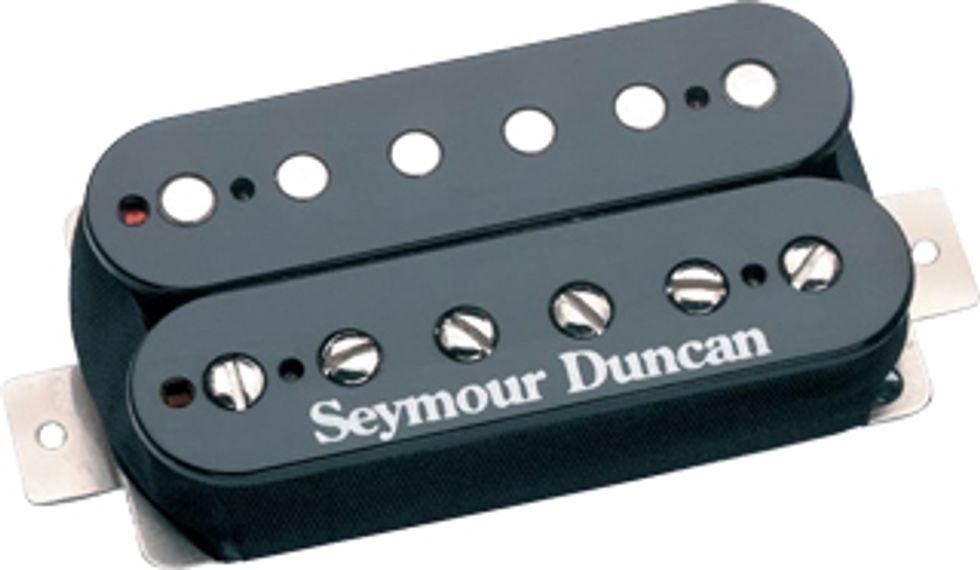
The ’59/Custom Hybrid humbucker isn’t your typical Seymour Duncan offering. At its root, it’s the offspring of two very popular Duncan humbuckers. The concept began with a fan talking on the company’s online forum about how he’d experimented with combining coils from Duncan ’59 and Custom pickups. The resulting blend of woody PAF tone and modern humbucking power not only impressed the forum member, but also maestro Duncan himself—so much so that the modified pickup was introduced as a standard production model.
A Meeting of the Minds
The SH-16 is a true hybrid of the ’59 and
the Custom—it mates a ’59’s screws-side
coil with a Custom’s slug-side coil, and
powers them with an alnico 5 magnet.
It’s designed specifically for the bridge
position (Duncan recommends pairing it
with a full-size ’59 or Alnico II Pro in the
neck position), and has a DC resistance
of 11.5k Ω. The pickup also uses four-conductor
wire for coil tapping and out-of-phase switching, if that’s your fancy.
Interestingly, individual coils are wound using different gauges of pickup wire, which is responsible for much of the pickup’s unique character. The ’59 coil uses thicker, 42-gauge wire, which is commonly used for PAF-style pickups for its clarity and openness at lower resistance (7k–9k). The Custom coil uses thinner, 43-gauge wire, which yields a crisper, more immediate attack, tighter lows, and additional compression when wound for higher output (14.1k Ω in a standard Custom). The coil mismatch can feel and sound strange at first—especially if you’re used to contemporary humbucking tones. It’s a great setup if you need single-coil tones, however. Coil-tapping knocks the ’59 coil out, leaving only the hotter Custom coil, which rates at a healthy 7.1k Ω for spanky, Strat-like tones.
A Whole New Ball Game
Compared to the stock ’57 Classic bridge
pickup in our Gibson Les Paul Traditional
test instrument, the SH-16 exhibited an
uncommon range of output and harmonic
content. Through a Fender Twin Reverb, the
Duncan sang with a familiar midrange growl
not unlike the stock Gibson pickup, but
with a more authoritative stance and attitude.
The alnico 5 magnet in the Duncan
likely has a hand in making the Duncan
bark louder than the Les Paul’s stock pickup,
which is built around a softer-sounding
alnico 2 magnet. Top end from the Duncan
also had a sparkling quality that made it
sound more alive—an attribute you can hear
loud and clear even when softly fingerpicking
progressions on the lower strings.
Ratings
Pros:
Unique voicing with great detail and harmonics.
Cons:
High notes can sound slightly brash with high
gain settings.
Tones:
Versatility:
Build:
Value:
Street:
$89
Combining the SH-16 with the Gibson’s low-output ’57 Classic neck pickup provided a beautiful contrasting tone. While the ’57 Classic filled the room with warm, thick lows, the SH-16 offered a bold contrast—a mix of rich mids and singing highs that were wonderfully reactive to picking dynamics.
The ’59/Custom Hybrid is even better at dishing out overdriven rhythms. Through a Mesa/Boogie Dual Rectifier’s orange channel, the Duncan opens up wide with a rich growl that was very difficult to muddy up—even with preamp gain absurdly high. Pick attack cuts through with extreme clarity that will be a godsend for modern rockers who like to hear every detail of a furious shredding salvo. In these high-gain environments, the pickup’s highs and upper mids aren’t shrill or overly bright, though the attack and high end sometimes felt a little pointed when playing up high around the 15th and 17th frets.
The Verdict
If you’re after a vintage-tinged pickup that has
a unique edge and enough modern muscle to
play harder styles of music, then you really need
to try the ’59/Custom Hybrid. It masterfully
melds the robust and classic sonic elements
of the ’59 with the aggression of the Custom,
resulting in a very detailed and responsive midrange.
The Duncan’s more in-your-face nature
might take some getting used to if you’re accustomed
to more even, less-dynamic tones, but if
you’re looking for something different that can
handle both clean and overdriven sounds with
ease, then the SH-16 is a must-try.







![Rig Rundown: Russian Circles’ Mike Sullivan [2025]](https://www.premierguitar.com/media-library/youtube.jpg?id=62303631&width=1245&height=700&quality=70&coordinates=0%2C0%2C0%2C0)

















